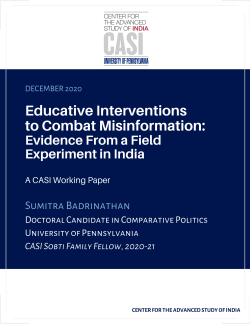Reshaping Adolescents' Gender Attitudes: Evidence from a School-Based Experiment in India
(English captions & Hindi subtitles available)
Farmers & Markets: Understanding Indian Agricultural Markets Across States & Commodities
(English captions & Hindi subtitles available)
India-Africa Health Partnership for the Pandemic Era

Of the many uncertainties brought on by the COVID-19 pandemic and the damage it has inflicted on global communities, economies, and systems, its impact on India has been especially grim. While the nature and devastation unleashed by the pandemic has caused nation states to adopt an insular and introspective approach, given the interconnectedness of world systems, it is crucial to examine how partnerships can be built around the process of recovery, especially with countries in Africa.
Talk Renewables, Walk Coal: The Paradox of India’s Energy Transition

Climate change affects countries, regions, and communities disproportionately. Places and populations already socio-economically vulnerable are set to bear the brunt of the global heating world. In the Indian context, recent research demonstrates that 75 percent of Indian districts are vulnerable to extreme climate events.
Natural Disasters and Child Marriages: A Case Study from Bihar

The past few months have been a time of great flux in India. While the economic slowdown and the COVID-19 crisis were the media’s central focus, two seemingly unrelated reports also appeared in this rapidly moving news cycle: a proposal to increase women’s legal age at marriage to 21 and floods in Eastern India. Although child marriage declined from 38.69 percent to 16.1 percent in the decade since the Child Marriage Act (2006) came into being, it is still a persistent phenomenon in Eastern India.
Data Privacy and Digitization of Health in India

On August 15, 2020, on the occasion of India’s 74th Independence Day, Prime Minister Narendra Modi announced the launch of the National Digital Health Mission (NDHM) with the promise that it will revolutionize the Indian health sector.

